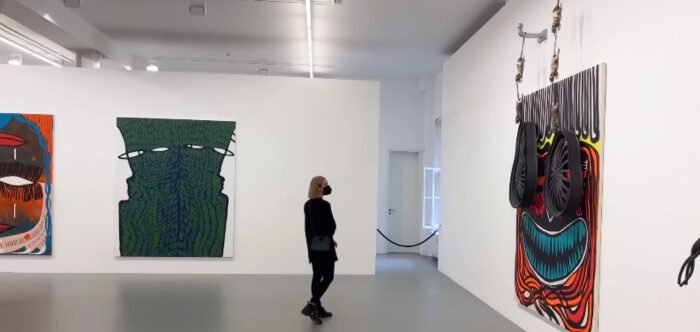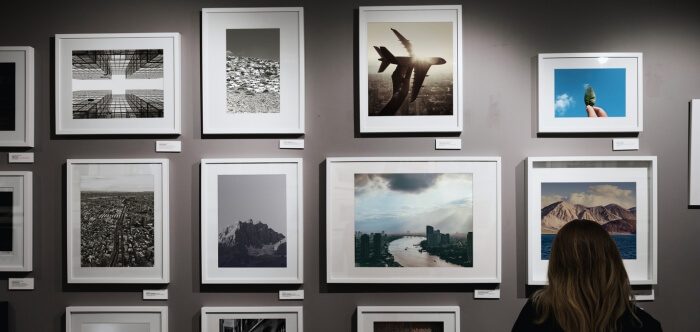Are you an art enthusiast looking to showcase your collection or an artist eager to display your work? Setting up an art exhibition can be a fulfilling yet complex endeavor. It’s not just about hanging art on walls; it involves a series of strategic steps. So, “How to set up an Art Exhibition?”
The answer lies in selecting a cohesive theme, carefully curating artwork, choosing the perfect venue, thoughtfully designing the layout, effectively promoting the event, arranging lighting and displays for maximum impact, and organizing a memorable opening night. Collaboration with artists and meticulous planning are the pillars of a successful show.
Eager to learn more? Dive into our blog for detailed insights and tips that will help you launch an art exhibition that leaves a lasting impression. Let’s embark on this artistic journey together!
Quick Overview of the Art Exhibition
Art exhibitions offer a unique platform for artists and art lovers to connect. They are vibrant events showcasing diverse talents and perspectives. These events become a nexus for cultural exchange, inspiration, and artistic appreciation.

Curating an exhibition involves a careful selection of artworks that resonate with the chosen theme. The venue plays a crucial role in enhancing the overall experience for visitors. Skillful arrangement and lighting can significantly impact how art is perceived and enjoyed.
Promotion is key to attracting a wide audience and gaining recognition. Social media, art networks, and community involvement are effective tools. Remember, the success of an art exhibition lies in meticulous planning and passion for art.
The Purpose of Setting Up an Art Exhibition
Art exhibitions are more than just displays of creativity; they’re a celebration of artistic expression and a bridge connecting artists with audiences. These events serve various purposes, each contributing to the vibrant tapestry of the art world. Here, we explore the multifaceted objectives behind setting up an art exhibition.
- Showcasing Talent: Art exhibitions provide a platform for artists to showcase their skills and creativity. They highlight the diversity and depth of artistic talent.
- Cultural Exchange: These events foster cultural exchange, allowing artists from different backgrounds to share their perspectives. They enrich the cultural landscape of a community.
- Educational Value: Exhibitions often have an educational aspect, offering insights into different art forms and techniques. They inspire and inform both artists and enthusiasts.
- Networking Opportunities: They create networking opportunities, connecting artists with galleries, collectors, and other professionals. These interactions can lead to future collaborations and projects.
- Market Exposure: For many artists, exhibitions are a way to gain market exposure. They provide a venue for selling artworks and establishing a market presence.
- Artistic Inspiration: These events serve as a source of inspiration for both artists and viewers. They encourage creative thinking and appreciation of various art forms.
Art exhibitions are a vital part of the art ecosystem, providing opportunities for growth, learning, and appreciation. They reinforce the importance of art in society and continue to inspire generations of artists and art lovers.
Popular Types of Art Exhibitions You Can Set Up
Art exhibitions are a diverse realm, offering a canvas for various creative expressions. Whether you’re an artist or a curator, choosing the right type of exhibition is crucial to convey your message effectively. Here, we explore popular types of art exhibitions that you can set up to captivate your audience and make a meaningful impact.
Solo Exhibitions
Solo exhibitions focus exclusively on the work of a single artist, allowing viewers to immerse themselves in the artist’s unique style, creativity, and artistic journey. They provide a comprehensive look at an individual artist’s body of work and are often used to showcase an artist’s mastery and evolution over time.
Group Exhibitions
Group exhibitions bring together artworks from multiple artists, offering a diverse and dynamic display of creativity. These exhibitions can revolve around a common theme or concept, encouraging interaction and dialogue among artists and viewers. They showcase the collective talent of a community or a group of artists united by a shared vision.
Juried Exhibitions
Juried exhibitions require artworks to undergo evaluation by a panel of judges who assess their artistic quality. These exhibitions can be competitive, offering emerging artists a chance to gain recognition and validation from experts in the field. Participating in juried exhibitions is a notable achievement.
Thematic Exhibitions
Thematic exhibitions revolve around a specific theme, concept, or idea. Artists are invited to interpret and contribute works that align with the chosen theme, resulting in a cohesive and thought-provoking display. Such exhibitions encourage viewers to explore the theme from multiple artistic perspectives.
Retrospective Exhibitions
Retrospective exhibitions are a tribute to an artist’s complete career and body of work. They offer a thorough glimpse into the artist’s creative journey, growth, and contributions to the art scene. Such exhibitions allow for contemplation of the artist’s influence and enduring legacy.
Pop-Up Exhibitions
Pop-up exhibitions are temporary and unconventional displays that often take place in unique locations outside traditional art galleries. They create a sense of novelty and surprise, attracting a diverse audience that may not typically visit art galleries. Pop-up exhibitions can infuse art into unexpected places, making art more accessible to the public.
Each type of art exhibition offers a unique experience for artists and viewers. The choice depends on your goals and message. Whether it’s a solo exhibit for personal focus or a group show for diversity, the art world embraces your creativity. Explore these options and unleash your imagination in exhibitions.
How to Set Up an Art Exhibition?
Preparing an art exhibition demands precision, thorough planning, and keen attention. Whether you’re an artist displaying your creations or a curator orchestrating an event, follow these step-by-step guides on how to set up an art exhibition to ensure a successful exhibition:

Step-1. Define Your Purpose
Begin by articulating the specific goals of your exhibition. Whether it’s showcasing your artistic growth, raising awareness about an issue, fostering community engagement through art, or simply sharing your passion with others, a clear purpose will shape your entire exhibition. It’s the foundation upon which you’ll build your artistic journey.
Step-2. Choose a Theme
The theme serves as the guiding narrative of your exhibition. Select a theme that speaks to your message and resonates with your target audience. It should evoke emotions, tell a story, or convey a concept that invites viewers to explore your artwork more deeply.
Step-3. Curate Your Artworks
The curation process involves not only selecting artworks but also ensuring they create a cohesive and engaging experience. Consider the progression of artworks, their arrangement, and how they relate to the theme. A well-curated exhibition can provoke thought and discussion.
Step-4. Secure a Venue
When choosing a venue, assess factors like location, accessibility, size, and aesthetics. Ensure the space complements your theme and can accommodate the technical requirements of displaying your artworks, such as lighting and hanging systems.
Step-5. Design the Layout
Plan the layout of your exhibition space with meticulous attention to detail. Consider the flow of the space, sightlines, and how viewers will navigate through the artworks. Adequate lighting is crucial to accentuate the beauty and details of each piece.
Step-6. Promote Your Exhibition
Develop a comprehensive marketing strategy that includes online and offline channels. Leverage social media, create an event website, and send out press releases to art publications. Engage with potential attendees and create anticipation through teasers and behind-the-scenes content.
Step-7. Organize the Opening
The opening night should be a memorable experience. Consider hosting artist talks, live demonstrations, or interactive art activities to engage attendees. Invite art influencers, collectors, and the local community. Make sure to have promotional materials and an email sign-up sheet to stay connected with your audience beyond the event.
By exploring each step in detail, you’ll be well-prepared to create an art exhibition that not only displays your art but also captivates and leaves a memorable impact on your audience.
How Much Does it Cost to Set Up an Art Exhibition?
The cost of organizing an art exhibition can vary significantly, typically ranging from a few hundred dollars to several thousand dollars. This variation is influenced by factors including venue rental, artwork preparation, promotional materials, insurance, transportation, and miscellaneous expenses.

Venue Rental
Venue costs can vary significantly based on location and prestige. Consider the duration of the exhibition, as renting the space for an extended period can increase expenses. Negotiating with venue owners for discounts or sponsorship deals can also impact the final cost.
Artwork Transportation and Installation
Transportation costs depend on the size and fragility of artworks. Custom crates, professional art handlers, and transit insurance are expenses to account for. Complex installations or the need for specialized equipment can also affect costs.
Promotional Expenses
The choice of promotional channels can influence expenses. Digital marketing is cost-effective but may require hiring a professional graphic designer or social media manager. Traditional advertising methods like print materials or mailers come with printing and distribution costs.
Lighting and Display
Investing in quality lighting can enhance the exhibition’s ambiance. LED lights are energy-efficient and versatile. Modular exhibition walls are flexible and reusable, providing a cost-effective display solution.
Insurance
Art insurance premiums can vary depending on the value of the artworks, their location, and the policy’s coverage. Working closely with an insurance agent experienced in art-related policies can help optimize costs.
Miscellaneous Costs
Consider the scale of your opening night reception and the number of guests when budgeting for refreshments. Opt for cost-effective signage materials and explore local regulations to avoid unexpected permit expenses.
keeping art exhibition costs in check means negotiating venue prices, planning transportation, using budget-friendly promotions, optimizing lighting, finding affordable insurance, and wisely spending on other expenses.
Common Mistakes to Avoid While Setting Up an Art Exhibition
Setting up an art exhibition is a creative endeavor, but it’s not without its potential pitfalls. Avoiding common mistakes can ensure a smooth and successful exhibition. Here are some key missteps to steer clear of:
- Lack of Clear Theme: Failing to define a clear theme can lead to a disjointed and confusing exhibition. A cohesive theme guides the selection and presentation of artworks.
- Inadequate Promotion: Neglecting marketing efforts can result in low attendance. Effective promotion through various channels is essential to attract viewers.
- Poor Lighting and Display: Inadequate lighting and subpar display methods can detract from the art’s impact. Invest in quality lighting and presentation materials.
- Overcrowding: Overloading the exhibition space with too many artworks can overwhelm viewers. Focus on quality over quantity to allow each piece to shine.
- Ignoring Logistics: Neglecting logistics like transportation, insurance, and security can lead to unexpected issues. Thoroughly plan and budget for these aspects.
- Lack of Engagement: Failing to engage with the audience can limit the exhibition’s impact. Provide context through labels, artist statements, or interactive elements.
A successful art exhibition requires careful planning, effective promotion, and attention to presentation details. Avoiding these common mistakes will help ensure a memorable and impactful showcase of artistry.
Conclusion
In setting up an art exhibition, the fusion of creativity and precise organization is key. It starts with a well-defined theme and carefully selected artworks that resonate with your audience.
Central to this process is “How to set up an Art Exhibition?”, where effective promotion and attention to lighting and layout are essential. These elements ensure the art is displayed in its best light, attracting and engaging viewers.
Finally, it’s about avoiding common mistakes like poor planning or inadequate marketing. A successful exhibition not only showcases art but also forms a bridge between the artist and the viewer, creating a memorable experience.


